How to Make Onion Soup Mix – No Bouillon or MSG
Here’s a homemade onion soup mix that’s straight up herbs and spices, no salt, bouillon, added MSG, sugar or preservatives. Delicious in dips, soups
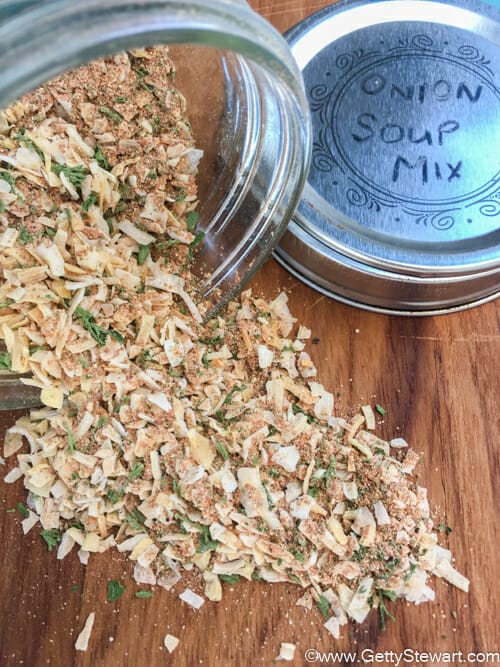
Also Read: Vegetable Quinoa & Lentil Soup Mix, Prairie Garden Soup Mix, Split Pea Soup Mix, Chicken Noodle Soup Mix
Happy to share my thoughts on these questions:
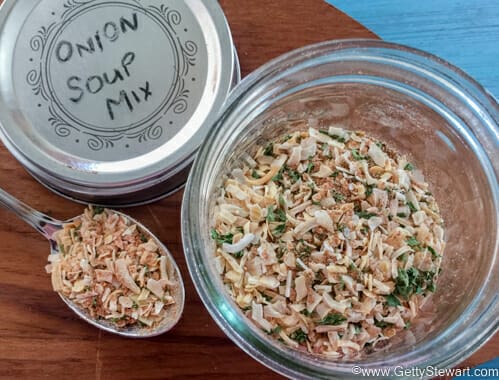
How Can I Use this Mix?
Use this dip as a seasoning mix to flavor anything where you want some bold, onion type flavor. Meats, stews, hamburgers, meatloaf, casserole, soups, bean patties, etc.
Use it as seasoning in this Vegetable Quinoa Soup Mix.
And try it with sour cream or Greek yogurt to make this delicious onion soup dip.
Why No Bouillon?
There are two main reasons why I do not add bouillon to my onion soup mix.
1. Onion Soup Mix is Rarely Used to Make Soup.
Have you ever used an onion soup mix package to make onion soup?
I didn’t think so. If you’re like most people, you use onion soup mix for dips, slow cooker meals and added flavor in dishes like hamburgers, meatloaves, casseroles and yes, even soup, although not necessarily onion soup. You use those packages for their bold onion flavor. That’s what you get with this onion soup mix.
I don’t want the added salt, sugar, color and preservatives that comes with the bouillon powder. I would rather add those ingredients myself by tasting and adjusting the food I’m preparing.
Follow this link for an awesome French Onion Soup recipe.
2. Personal Preferences for Bouillon or Stock.
Everyone, it seems, has an opinion on their preferred choice of broth or bouillon. Some cooks prefer homemade stock, some like cubes or powder, some like concentrated paste and others prefer boxed liquid broth. Any of those options will work with this soup mix. So if you are using this mix as a base for soups or stews, the choice of what to use is totally up to you!
Personally, I prefer to use homemade stock, but when I don’t have a fresh batch and the freezer supply has been used up, I use whatever bouillon I have in the cupboard (I still haven’t found one I absolutely love, right now I’m trying Better Than Bouillon). I rarely used boxed broth because of the cost, ingredients, cupboard space and environmental cost of transporting those cartons.
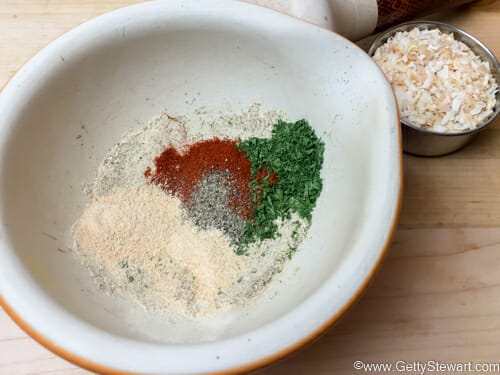
Why No Salt or Sugar?
In North America, we eat way too much salt and sugar. The majority of it comes from processed and packaged food. By leaving it out of this mix, you are in control of how much or how little salt or sugar you add to a particular recipe.
Let your taste buds be the guide, not whatever happens to be in the package. Add salt and sugar to taste just before serving.
Why No MSG?
Personally, I have mixed feelings about MSG or monosodium glutamate, just like I do with most preservatives. I eat them and am not obsessive about them, but I I prefer to limit my intake when I can. And limiting MSG is tough since it’s everywhere! So, when I have the option of making food without added MSG, I take that opportunity. That’s why this soup mix doesn’t contain any added MSG. That said there is glutamic acid naturally present in onion powder, garlic powder and most likely the celery seed too.
Here’s some of what I’ve discovered about MSG.
MSG is added to food, because it makes savory foods taste better. MSG boosts the umami of food – that pleasant savory, salty, meaty, seafoody flavor you experience with Parmesan cheese, Chinese food, sauteed mushrooms, shellfish, cured meats, etc. Food manufacturers, like the makers of Doritos, know that adding MSG boosts flavor and sales. Therefore it is found in tons of savory processed and prepared foods.
In 1908, Japanese professor, Kikunae Ikeda was the first to extract glutamate from seaweed broth and transform it into a white powder sold as MSG. Today, MSG is made by fermenting starch, sugar beets, sugar cane or molasses.
Glutamate is an amino acid and the component of MSG that gives us that yummy umami flavor. Glutamates can also be found in many foods, such as tomatoes, cheese, fish, shellfish, seaweed, meat, mushrooms, soy sauce, broccoli, peas, celery and even human breast milk. Health Canada references a study by the Federation of American Societies of Experimental Biology that states there is no difference in how the body synthesizes MSG and glutamates found naturally in foods.
Is MSG Safe?
Health Canada says “the use of MSG is not a health hazard to consumers.” It treats MSG as a flavour enhancing ingredient instead of a food additive and therefore sets no regulatory limit to the amount of MSG that may be added to food.
The US Food and Drug Administration has classified MSG as a food ingredient that’s “generally recognized as safe”, but does require it to be listed on food labels.
The Mayo Clinic says researchers have found no definitive evidence of a link between MSG and symptoms like headache, flushing, sweating, facial tightness, numbness, heart palpitations, chest pain, nausea or weakness. Although they do acknowledge there is a small percentage of people who may have short term reactions to MSG.
Contrary to scientific consensus, Dr. Russel Blaylock’s book on MSG warns that the excitotoxic effects of MSG are harmful to our brains. His research is quoted by Dr. Mercola, another doctor who holds many views contrary to mainstream health care providers. While stirring up debate, the concerns raised by Dr. Blaylcock have not been reproduced by other studies and are not considered conclusive.
How Long Will This Mix Last without Preservatives?
Ingredients in this onion soup mix are dehydrated and can be safely kept for many years in a dry, airtight container and not exposed to sunlight. However, over time, its flavor will start to diminish. For best flavor use within 6 to 12 months.
Onion Soup Mix Recipe
Onion Soup Mix
Ingredients
- 1/2 cup dried onion flakes
- 1 tsp onion powder
- 2 tsp dried parsley
- 1 tsp paprika
- 1 tsp garlic powder
- 1/4 tsp black pepper
- 1/2 tsp crushed celery seed
Instructions
- Combine all ingredients in a bowl and mix well.
- Transfer to airtight jar.
- Use with 6 to 12 months for best flavor, although will safely store longer.
Notes
Mix 2 Tbsp mix with 1 cup sour cream, 1/4 cup mayonnaise and 1/8 tsp salt. To Make Onion Soup:
Mix 1/4 cup mix with 2 cups beef stock.
Nutrition Facts (per serving)
Other Seasoning Blends
I love homemade seasoning blends. By mixing them ahead of time, I save the hassle of trying to find multiple spice jars when cooking weeknight meals. My favourites are:
- Italian Herb Seasoning – for any tomato sauce, Italian dish, on steamed or roasted veggies, croutons or pita crisps
- Taco Seasoning – for any Mexican inspired dish
- Cajun Spice Mix – for roasted chickpeas and popcorn
- Lemon Herb Seasoning – great on veggies, fish or chicken
- Pie Spice – whenever a recipe calls for cinnamon and you want a little added touch
Well that’s a lot of info for a simple onion soup mix! All you really need to know is that this mix is tasty delicious and makes an awesome veggie or chip dip.
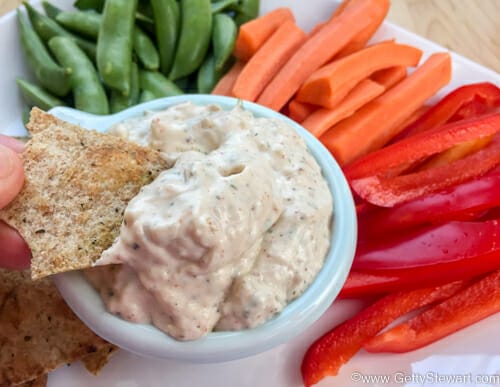
It’s your turn. I’ve shared a lot of my thoughts about food in this post, I’d love to hear where your at? Do you think of any of these things or are you just interested in good food? I’d love to hear from you either in the comments below or on instagram @getgettys or Facebook @GettyStewart.HomeEconomist.


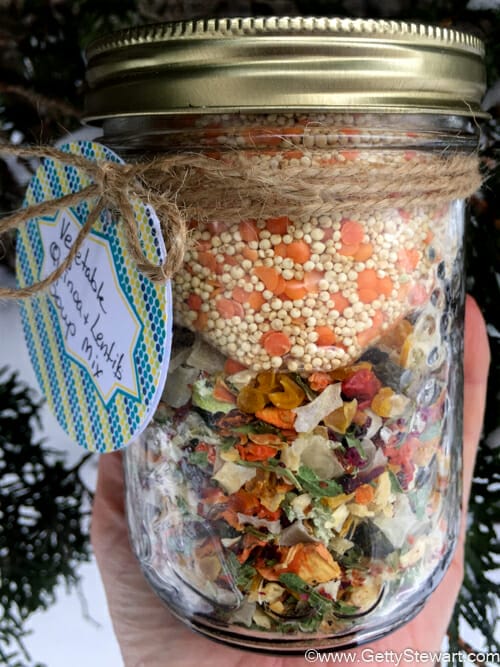
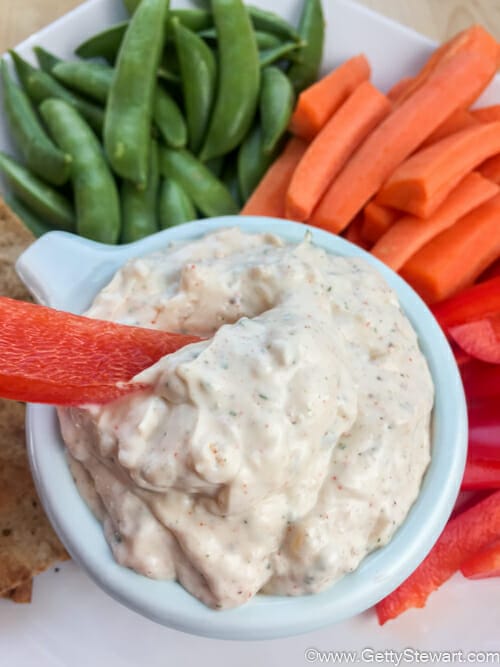
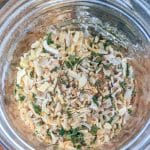
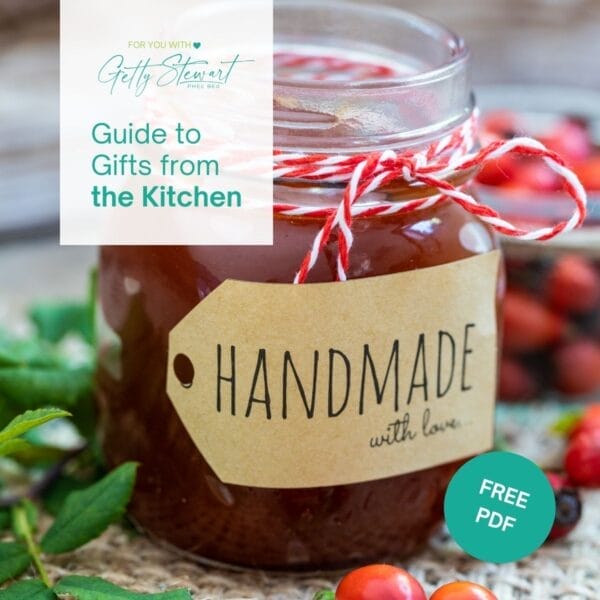
I love this post! I have a family member who is particularly sensitive to MSG, and we’ve been trying to eliminate it (added MSG) from our diet. I’ve been discovering that it’s not that easy, but this recipe gives me some gastronomic hope! We grow our own onions and a food dehydrator is on our wish list for this summer, so this will be the perfect recipe to try out.
Awesome, thanks for your feedback Heather. It’s great to know that my posts are helpful. Dehydrating your own herbs and veggies will definitely create a lot of exciting opportunities for you. Just a word of caution – onions, garlic, leeks and mushrooms can be very smelly when dehydrating – do this in the garage or outside space! I explain more on the onion dehydrating post – when you’re at that stage, I highly recommend you have a look.
Getty